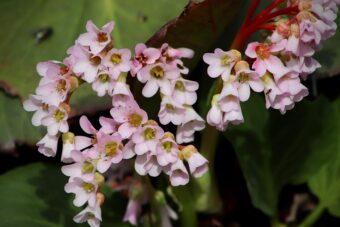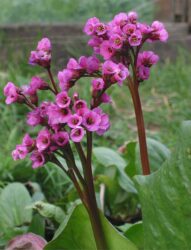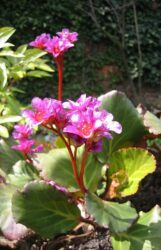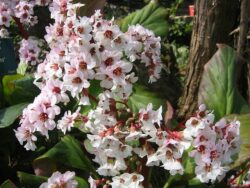In this article, we will discover how to grow the evergreen Bergenias in containers. Bergenia or Elephant’s ears is such an elegant plant that gets better looking in winter. This is such a rare feat for plants, especially in the container garden. They have clumps of large oval leaves that take on richer hues when the temperature drops.

Bergenia purpurascens and B. ‘Abendglut’ are classical varieties that do this. All varieties can be grown but the more compact varieties are recommended for containers such as ‘Wintermarchen’.
The common name comes about because of the bold leaves, even though they do not even look like elephant ears.
They are traditionally used in shady areas of the garden, where very little will grow. But they are much more versatile than this.
I have seen them growing successfully in full sun. Modern varieties are more compact and have more interest in winter, where the leaves can take a red or burgundy hue.
In spring, pink, purple, white or red flowers appear, giving a complete look. They are an excellent source of nectar for pollinating insects at the beginning of the new growing season. In general, they are a low maintenance plant.
They make an excellent choice in front of container displays, where the leaves will contrast with ferns. They will also look great in exotic plant schemes along gravel paths.
HOW TO PLANT BERGENIAS IN CONTAINERS
First, you need a large container around 40cm in diameter with plenty of drainage holes. Although they like moisture they do not like their roots to be soggy. Fill the container with some crocks and then fill it with moisture-retentive, multipurpose compost. Dig a hole that is a little bigger than the size of the root ball it came in the original container and place the plant in at the same level it was in the original container- no deeper or shallower.

Backfill with the growing media and add more compost ensuring that no gaps remain. Firm the plant in and water well to settle the compost.
In early spring, give a feed with a handful of slow-release fertilizer, In summer, give a monthly feed of liquid fertiliser until autumn begins, Continue to water well, especially so in hot, dry weather. Water when the compost feels dry to the touch, as this is a moisture-loving plant.
After flowering in late spring add a layer of well-rotted compost as a mulch to help suppress weeds and to help retain moisture. At this time, it is best to remove tatty, dead leaves and spent flowers to main a presentable look. It will need to be divided every few years to keep the plant healthy and productive.
Bergenias spread via underground rhizomes and this is the best way to propagate them. In spring (after flowering) or in autumn, take the plant out of its container. Discard the old woody centre and cut the remaining rhizomes into equal sized sections, making sure each division has one leaf emerging from it. These can be grown in new containers to bring you future joy.
PESTS AND DISEASES
Dark spots on the leaves is an indication of fungal leaf diseases. They will gradually get bigger in size. The spots are often brown, papery and have a yellow halo. If you notice this remove any affected leaves and move the plant to increase the spacings between them. Water at the base of the plant and in the morning to avoid splashing the leaves with water.

Curling leaves and dark rhizomes indicate rhizome rot. At this stage, your plant may be beyond saving. You may be able to divide and replant any healthy rhizomes, but it is a risk and it could be a waste of time.
Slug and snails hide behind the leaves and they can make holes in them. The best way to deal with them is to remove any decaying leaves where they tend to hide.
Vine weevil can cause small notches in leaves in spring and summer. The grubs may eat the roots in autumn and winter. They tend to be a nuisance but if the problem is severe you can use biological control in August and September. Growing in a bright, open area will limit the damage.
VARIETIES TO GROW
Many varieties can be grown in the container garden, some of the best ones are:
Bergenia ‘Dragonfly Angel Kiss’ has leaves that turn a claret-red in winter, In spring it has white flowers that turn pale pink with age.
Bergenia cordifolia ‘Purpurea’ has green leaves that are red flush but in winter they turn a rich purple. In spring Cerise flowers appear.

Bergenia ‘Abendglut’ has dark green leaves that turn maroon in winter and in spring magenta flowers appear.
Bergenia ‘Overture’ is a plant that has green leaves that turn claret red in winter. In spring, scarlet stems with magenta-red flowers appear.
Bergenia ‘Silberlicht’ has green leaves and in spring on red-flushed stems, white flowers appear that turns pink as they age.
Bergenia purpurascens has glossy green leaves that turn a deep red in winter. In spring, pink flowers appear that are carried in nodding clusters upon upright red stems.
CONCLUSIONS
In this article, we have discussed how to grow Bergenias in containers. As you can see they are beautiful plants that not only have colourful blooms in spring but often vivid red clouted leaves in winter, They are easy to look after, only feeding in summer, water when it is dry and some tidying up in summer,
They can suffer from pests and diseases but most are easy to deal with. All you need to do is remove dead leaves, spent blooms and practise good husbandry. A plant that should be grown in a container.
If you have any questions or comments that you wish to make on growing Bergenias in containers, please do so in the comment box below.
Happy Bergenia growing.
